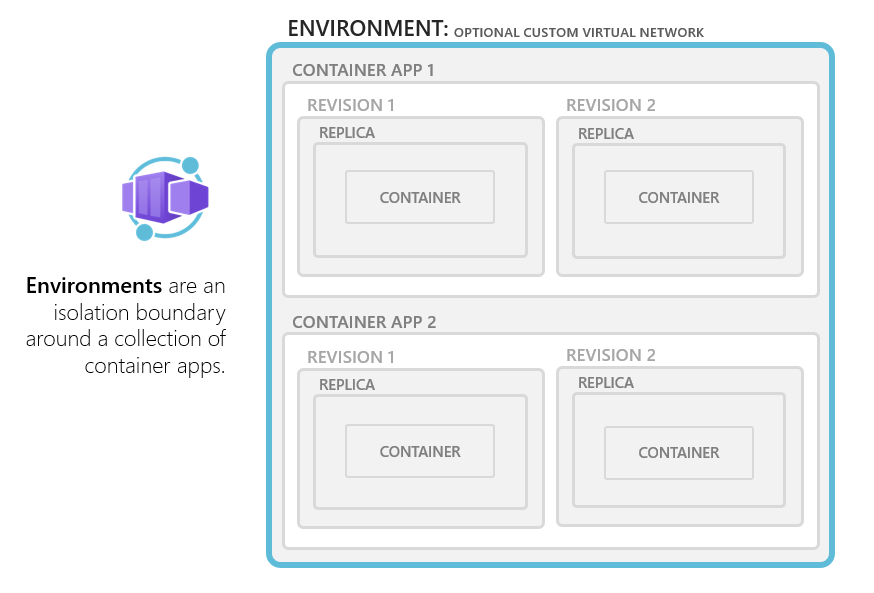Azure Container Apps environments
A Container Apps environment is a secure boundary around one or more container apps and jobs. The Container Apps runtime manages each environment by handling OS upgrades, scale operations, failover procedures, and resource balancing.
Environments include the following features:
| Feature | Description |
|---|---|
| Type | There are two different types of Container Apps environments: Workload profiles environments and Consumption only environments. Workload profiles environments support both the Consumption and Dedicated plans whereas Consumption only environments support only the Consumption plan. |
| Virtual network | A virtual network supports each environment, which enforces the environment's secure boundaries. As you create an environment, a virtual network that has limited network capabilities is created for you, or you can provide your own. Adding an existing virtual network gives you fine-grained control over your network. |
| Multiple container apps | When multiple container apps are in the same environment, they share the same virtual network and write logs to the same logging destination. |
| Multi-service integration | You can add Azure Functions and Azure Spring Apps to your Azure Container Apps environment. |

Depending on your needs, you may want to use one or more Container Apps environments. Use the following criteria to help you decide if you should use a single or multiple environments.
Single environment
Use a single environment when you want to:
- Manage related services
- Deploy different applications to the same virtual network
- Instrument Dapr applications that communicate via the Dapr service invocation API
- Have applications share the same Dapr configuration
- Have applications share the same log destination
Multiple environments
Use more than one environment when you want two or more applications to:
- Never share the same compute resources
- Not communicate via the Dapr service invocation API
- Be isolated due to team or environment usage (for example, test vs. production)
Types
| Type | Description | Plan | Billing considerations |
|---|---|---|---|
| Workload profile | Run serverless apps with support for scale-to-zero and pay only for resources your apps use with the consumption profile. You can also run apps with customized hardware and increased cost predictability using dedicated workload profiles. | Consumption and Dedicated | You can choose to run apps under either or both plans using separate workload profiles. The Dedicated plan has a fixed cost for the entire environment regardless of how many workload profiles you're using. |
| Consumption only | Run serverless apps with support for scale-to-zero and pay only for resources your apps use. | Consumption only | Billed only for individual container apps and their resource usage. There's no cost associated with the Container Apps environment. |
Logs
Settings relevant to the Azure Container Apps environment API resource.
| Property | Description |
|---|---|
properties.appLogsConfiguration |
Used for configuring the Log Analytics workspace where logs for all apps in the environment are published. |
properties.containerAppsConfiguration.daprAIInstrumentationKey |
App Insights instrumentation key provided to Dapr for tracing |
Policies
Azure Container Apps environments are automatically deleted if one of the following conditions is detected for longer than 90 days:
- In an idle state
- In a failed state due to VNet or Azure Policy configuration
- Blocks infrastructure updates due to VNet or Azure Policy configuration
Next steps
Feedback
Coming soon: Throughout 2024 we will be phasing out GitHub Issues as the feedback mechanism for content and replacing it with a new feedback system. For more information see: https://aka.ms/ContentUserFeedback.
Submit and view feedback for